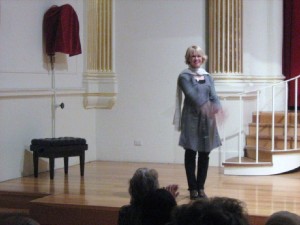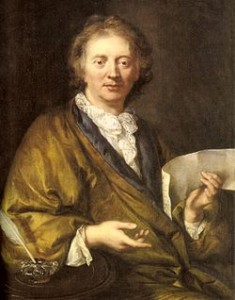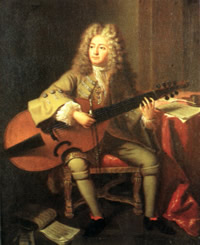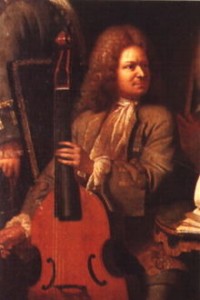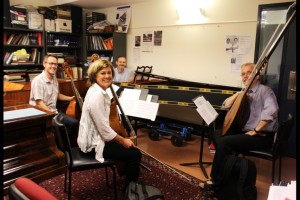(Almost) forgotten greats and modern masters
Couperin, Forqueray, Dollé, Marais, D’Hervelois. How many 21st century music-lovers are familiar with any of the above names? Yet back in the days when Louis XIV ruled France, they were celebrity composers for the viola da gamba and household names across Europe. Now in an ambitious move viola da gambist and Marais Project founder, Jennifer Eriksson, has put together a concert that revives the fortunes of these five neglected greats and features a newly commissioned work by Australian composer, Rosalind Page.
5 Frenchmen + 1 Australian woman = “6 of the Best”
“By necessity I’ve conceived this concert in the style of an iPod play list”, Eriksson commented”, “It’s a kind of like a ‘taster’ concert, an introduction to the hundreds of valuable works these fabulous viola da gamba composers produced.” “The premiere of Rosalind’s piece is an added bonus.”
In recognition of the significance of this event NSW Arts, the State Government arts funding body, recently awarded Eriksson a scholarship to take up a Short Term Winter Residency at the prestigious Banff Arts Centre, Canada, where she spent five weeks practicing for “Six of the Best” and engaging in her hobby, running, amongst the snow covered peaks!.”Banff was amazing”, Eriksson commented, “It is one of the largest arts centres in the world and situated in the beautiful Canadian Rockies.” “I benefited greatly from the opportunity to meet other international artists and practice six hours a day!”
“Six of the Best” launches The Marais Project’s 2013 concert series, its 14th consecutive year of presenting fine music for the viola da gamba.
Logistics
Date: Thursday 11 April, 2013 Time: 7.00pm Venue: Sydney Conservatorium, Macquarie St, Sydney Cost: $30/20; online www.maraisproject.com.au; ph 02 9809 5185The composers
François Couperin (10 November 1668 – 11 September 1733) was a French Baroque composer, organist and harpsichordist. He was known as Couperin le Grand to distinguish him from other members of the musically talented Couperin family. Couperin was widely respected during his life – JS Bach was an admirer – and has subsequently inspired a range of composers from Brahms to Ravel. He also wrote two suites for the viola da gamba. Jordi Savall has written that Couperin was the “poet musician par excellence”, who believed in “the ability of Music [with a capital M] to express itself in prose and poetry”, and that “if we enter into the poetry of music we discover that it carries grace that is more beautiful than beauty itself”.
Marin Marais (31 May 1656, Paris – 15 August 1728, Paris) was a French composer and viol player. He studied composition with Jean-Baptiste Lully, often conducting his operas, and with master of the bass viol Monsieur de Sainte-Colombe for six months. He was hired as a musician in 1676 to the royal court of Versailles. He did well as court musician, and in 1679 was appointed ordinaire de la chambre du roy pour la viole, a title he kept until 1725. He was a master of the basse de viol, and the leading French composer of music for the instrument. He wrote five books of Pièces de viole (1686–1725) for the instrument, generally suites with basso continuo. These were popular in the court, and for these he was remembered in later years as he who “founded and firmly established the empire of the viol” (Hubert Le Blanc, 1740). His other works include a book of Pièces en trio (1692) and four operas (1693–1709), Alcyone (1706) being noted for its tempest scene.
Caix d’Hervelois (ca. 1670, France–18 October 1759, France) wrote music almost exclusively for the viol. Most of his other works exist as transcriptions from his viol music. Louis de Caix d’Hervelois was a pupil of the great Marin Marais. Caix’s tuneful, graceful music is firmly in the French tradition of character pieces in dance suites. It is among the most idiomatic music written for the viol, its apparent simplicity deepening when interpreted in the light of the traditions of French viol performance practice. The French musicologist Philippe Beaussant wrote of Caix’s music and anonymity: “One might look upon Caix d’Hervelois as a sort of pseudonym masking a person whose name was ‘the Viol of France,’ just at the moment when it was about to disappear.”
Charles Dollé (fl. 1735 – 1755) was a French viol player and composer. Very little is known about his life. He was active in Paris and was a sought-after teacher of viol. His music, all of which involves the viol in some way, was influenced by Marin Marais (whose death the composer commemorated in a tombeau) and Italian style, which is most prominent in Dollé’s late works (although they retain the characteristically French ornamentation). Dollé’s music survives in five printed collections (all published in Paris).
Antoine Forqueray (September 1671 – 28 June 1745) was a French composer and virtuoso of the viola da gamba. Forqueray, born in Paris, was the first in a line of composers who included his brother Michel (1681–1757) and his sons Jean-Baptiste (1699–1782) and Nicolas Gilles (1703–1761). Forqueray was named musicien ordinaire of La chambre du Roy of Louis XIV in 1689 and played at court. Until 1710, he was accompanied by his wife on the harpsichord in his recitals. In 1730, he retired to Mantes-la-Jolie, where he died in 1745. His son published his works for the viola de gamba in 1747 (two years after his father’s death) together with a version for harpsichord. Marin Marais and Antoine Forqueray were considered by their contemporaries as the two greatest virtuosi of the viola da gamba.
Composer and writer Rosalind Page studied composition at Sydney Conservatorium of Music from 1990-91 with further studies in North America, graduating with a B.A. (Mus) Summa cum laude from the University of Delaware, USA. In 1994, she was honoured as a winner of the University of Delaware’s Edward H. Rosenberry Award for Excellence in Writing. Upon her return to Australia, Page undertook a Master of Arts (Theatre and Film Studies) in 1996 at UNSW, researching sound and image relationships in the films of Andrei Tarkovsky. In 2006, she completed her PhD in composition with Ross Edwards at the University of Sydney. Rosalind has been commissioned by numerous prestigious ensembles and artists. This is the second work she has written for The Marais Project.
Program – directed by Jennifer Eriksson
Antoine Forqueray (1671 – 1745) Pièces de viole suite in G major
- Chaconne La Buisson
François Couperin (1668 – 1733) Pièces de viole, suite in E minor
- Prelude gravement
- Allemande légere
- Sarabande grave
- Gavotte gracieusement sans lenteur
- Passacaille ou Chaconne
Louis de Caix d’Hervelois (1670 – 1759) Pièces de viole, Premier Livre, suite in D minor
- Prelude
- l’Henriette legerement
- La Villageoise
- La Bagatelle
- La Luthée
- Gigue
- Menuet
Charles Dollé (1735 – 1755) Pièces de viole, suite in G major
- Prelude
- Allemande La Mantry
- La Badine legerment
Rosalind Page Piece for viola da gamba and theorbo, World Premiere
- Columba (2013)
Marin Marais (1656 – 1728) Pièces de viole, 3e Livre, suite in A minor
- Prelude,
- Grand Ballet
The Performers
Jennifer Eriksson & Daniel Yeadon – viola da gamba
Tommie Andersson – theorbo
Raymond Harvey – harpsichord

